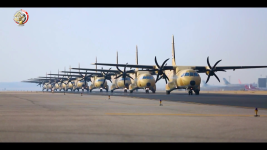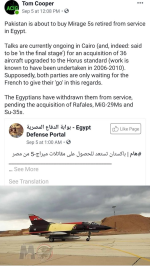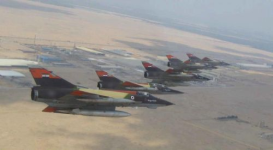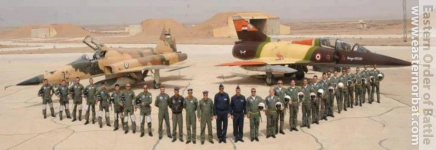Navigation
Install the app
How to install the app on iOS
Follow along with the video below to see how to install our site as a web app on your home screen.
Note: This feature may not be available in some browsers.
More options
Style variation
You are using an out of date browser. It may not display this or other websites correctly.
You should upgrade or use an alternative browser.
You should upgrade or use an alternative browser.
Egyptian Armed Forces
- Thread starter The SC
- Start date
GoMig-21
Elite Member
- Oct 16, 2016
- 9,269
- 14,353
- Country of Origin

- Country of Residence

GoMig-21
Elite Member
- Oct 16, 2016
- 9,269
- 14,353
- Country of Origin

- Country of Residence

The SC
INT'L MOD
- Feb 13, 2012
- 41,126
- 40,410
- Country of Origin

- Country of Residence

- Thread starter
- #923
Egypt’s Soviet-Era, Chinese-Made, American-Upgraded Subs Can Still Fire Harpoon Missiles

The Egyptian Navy recently released a short, but very interesting video offering a close look at a recent training exercise in the Mediterranean, with a particular emphasis on one of the country’s four remaining Cold War vintage Romeo class diesel-electric attack submarines. Egypt is one of just two remaining operators of variants of this type, the other being North Korea, which revealed earlier this year that it was converting one of its examples into a new ballistic missile submarine, something you can read about in more detail in this past War Zone story. The remaining Egyptian examples, all of which originally came from China, are unique to the country, having gone through a major refit with U.S. assistance in the late 1980s and early 1990s that, among other things, allow them to fire UGM-84 Harpoon anti-ship missiles.
The Egyptian Ministry of Defense released the video on its official YouTube page on Dec. 11, 2019. The Romeo class submarine with the hull number 849 took part in the exercise, as well as one of the country’s much newer German-made Type 209/1400mod diesel-electric boats. The Gamal Abdel Nasser, one of the country’s two French-built Mistral class amphibious assault ships, which you can read about in much more detail here, was also present, with AH-64 Apache attack helicopters and CH-47 Chinook transports operating from its flight deck. At least two Gowind class corvettes, which Egypt also acquired from France, participated, as well.
Clips of the Romeo, inside and out, took up a significant portion of the video’s runtime. The interior shots offer something of an unusual view, showing a submarine filled with a mixture of archaic gauges, valve handwheels, and other features that underscore the age of the underlying design, coupled with much more modern radar screens, computers, and other improvements, some of which are also now more than 25 years old. It all being a product of Egypt’s somewhat curious history with these submarines.
The Soviet Union first began building Romeos, which displace around 1,830 tons submerged, in the 1950s as successors to the country’s first post-World War II submarines, which were derived from captured Nazi U-boat designs. Prior to the Sino-Soviet split, the Chinese received the requisite technical data package to begin building examples of their own, which they called Type 033s.
Between 1982 and 1984, the Egyptian Navy received another four Type 033s from China in a unique configuration known as the ES5A.
The ES5As replaced a number of Soviet-designed systems with more modern Chinese designs, including new sonars, communications equipment, and periscopes. There were also unspecified improvements that reduced their acoustic signature, something that is absolutely vital to reducing any submarine’s vulnerability to detection and attack.
The Chinese subsequently offered Egypt a refit package in the mid-1980s to bring its fleet of Romeos and Type 033s up to a similar standard, known as the ES5B. Reportedly, the submarines in this updated configuration were 20 decibels quieter than the original Soviet design, a nearly 13 percent reduction in the boat’s acoustic signature. Their submerged top speed of 13 knots remained unchanged.
In 1988, the State Department approved a plan wherein a company called Tacoma Boatyard in the Washington State city of the same name would further modernize the remaining submarines, according to one edition of the Naval Institute’s Combat Fleets. The refit was extensive, giving the boats the ability to fire torpedo-tube-launched UGM-84 Harpoon anti-ship cruise missiles and Mk 37 Mod 1 wire-guided torpedoes, according to one edition of Jane’s Fighting Ships. The recent video shows submarine 849 firing a Harpoon.
The boats also received new active and passive sonars from American defense contractor Loral and German firm Atlas Elektronik, respectively. Atlas Elektronik also supplied a new fire control system.
The Romeos, as is apparent from the Egyptian Ministry of Defense’s recent video, will remain an active part of the country’s naval capabilities, despite their increasing age. Especially with their ability to launch Harpoons, which provide the ability to conduct stand-off anti-ship attacks, they present at least some level of threat to more modern ships in service with potential opponents in the region.

MAZ-543 upgraded with German diesel engines in 2004
The Israeli side is trying to show that the Egyptians are dangerous and have ballistic missiles to obtain more American weapons. We explain the matter simply.
Israel has 20 major targets including 13 air bases
The rest are land bases and ports, so if each base is bombed, the equivalent of 100 missiles, without counting the Egyptian Air Force, of course.
To implement a high rate of destruction
The real game changer is the tactical missiles. Egypt, for example, owns only 100 WS-2D platforms with a range of up to 400 kilometers, and its presence in Sinai is the point where it can carry out good strikes up to 60% of what Israel calls it, and provide large numbers of ballistic missiles to other targets inside Israel, from power stations, water, factories and ports. And other infrastructure
This is well known to Israel, which causes them deterrence, especially since Egypt. These weapons are considered part of the Egyptian defense systems, unlike the air force and the widespread proliferation of UCAV drones.
Which Egypt mobilizes from various global sources, we manage the battles with combined weapons systems
With the same idea and technology as future weapons, even if they use obsolete weapons
Maximizing the use of old weapons and recycling them. The issue here is not to have 2,000 ballistic missiles in Egypt, but rather to benefit from hundreds of old fighters and convert them into UCAV aircraft.
Recycling old air defense missiles into artillery missiles, in addition to the weapons we possess, here lies the benefit.
The same idea is to repurpose old tanks that are in excellent condition despite their progress, by equipping them with new weapons and turrets to maximize their usefulness as a platform, even if they are used for other tasks.
In other words, Egyptian ballistic missiles are considered part of the defense system, no matter how large their size. They represent a limited part of deterrence. Egypt basically knows the true destructive capabilities of ballistic missiles, which are limited, and their importance lies in their accuracy and selection of targets, whose loss to the enemy side represents a significant impact on its defensive ability along with the rest of the system. Egyptian combat
In addition to what was mentioned, the presence of large numbers of tactical missiles, such as derivatives of the DV-12/M20 and PALARY missiles, continues to have a significant impact due to the proximity of the targeting areas inside Israel, such as American weapons stores in the Negev and the air base there that was established in violation of the Camp David Agreement and with claims that it is secret.
Imad Adeeb: Egypt has the Russian Iskander missile
Iskander-M mobile short-range ballistic missile systems
View attachment 56259
*This writer journalist is not just any journalist in Egypt, the Guy is very well respected..And never says things out of place..
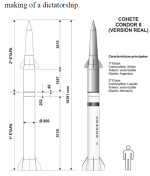
It is not of high value for the simple reason that the deal is for a limited number of 100 missiles to replace the first batch of SCUD-B missiles that Egypt received in 1973.
To clarify important matters, the missile production line in the countries is equivalent to 50 missiles annually. With the spread of short-range missiles and the increasing demand for them, the demand for the 300 kilometer category has become considered large numbers, which makes the demand to add another production line other than medium-range missiles. So we find, for example, that America had 2000 ATACMS missiles. Also, ballistic missiles began to be used as anti-ship missiles, which expanded the need for other preparations for this mission. We find that the success of countries like Iran in reducing the cost of missile production made Iran possess an estimated 4,000 missiles, while the Iskander missile’s price is estimated at between 3-5 million dollars, so the M20 missile is more expensive. Popular and more widespread, and for this reason also Egypt wants to obtain subsidiary technologies for the Indian PALARY missile for various reasons, including unless China provides it to Egypt to ensure the import of a part of the Chinese missiles, otherwise Egypt will continue to be a client of China. Also, the missile engine’s characteristics and its high accuracy are required to raise the efficiency of the Egyptian local product. And also to replace local versions of the locally manufactured Egyptian LUNA missile, modified with a range of 150 kilometers

The Israeli propaganda about the Egyptian missile program remains ridiculous because the West and the East were simply unable to control the North Korean and Iranian missile programs. Therefore, even countries affiliated with America, such as South Korea, Turkey, and Saudi Arabia, were overlooked for their possession of ballistic missiles, and thus any restrictions lost their value.
The point that some do not understand is that Egypt does not use military capabilities except within narrow limits, always as a message of deterrence. The limited strikes that were carried out on Libya in 2015, or even the attack on the Wattiya base, had an effect in restricting the conflict with limited deterrence. Egypt Therefore, do not resort to force except as a final solution, and America knows full well that Israel’s fear of Egypt leads to peace for both parties.

The Egyptian air transport fleet needs to replace a large number of aircraft
The best option for replacing the needs is related to two aircraft
The first is the Embraer C-390. The needs for this model are large for several reasons. Egypt requested 12 C-130J aircraft, this number to replace the DHC-5 aircraft, and part of them were used as maritime patrol aircraft
Therefore, Egypt needs to replace at least 24 C-130H aircraft for the transport sector
Heavy aircraft Egypt had specified its request for 20 Y-20 aircraft
66 tons of payload and is a replacement for an old request for the IL-76 aircraft
These aircraft are used as platforms for tanker aircraft, early warning aircraft, and even as a truck for transporting cruise missile containers. Each container carries a cruise missile that is launched from the transport aircraft
Using commercial civilian transport versions that depend on offsets for aircraft such as the C-390. In the case of local assembly, the scope of use of the aircraft will be expanded by distributing 12 aircraft for transport 25 ton loads on commercial companies such as EgyptAir, which expands the local aircraft production system, in addition to military transport requests that are expanding as a result of the Air Force's monopoly on transferring urgent grants and aid to African countries.
China, after producing more than 60 Y-20 aircraft, as well as producing the national WS-20 engine for it, which removes any Russian restrictions on exports, simply makes China more flexible in exporting. It has already begun offering the aircraft for export to Nigeria.
Egypt's presence in the BRICS organization will allow Egypt to buy in national currencies and remove the dollar from the list of transactions, which facilitates trade exchange between countries in the BRICS group.
The Egyptian option for the C-130J aircraft was rejected by those interested in the military group, and we consider the deal only to operate the American production lines, especially since the price of the C-130J aircraft is much higher than the C-390 aircraft, which Brazil offered to India at a low price, in addition to the superiority of the Brazilian aircraft in payload and range.

The Egyptians have two problems. They do not want us to invest in industrial production in general, and they consider the matter to be heading towards what the president agreed to. Countries or the leadership of the Arab Organization for Industrialization with its failed leadership that destroys any project or industry due to corrupt management, as they consider trade in lands and strategic goods to be more profitable than developing industrial and agricultural production that adds value to the national economy, and they consider the solution just as the Russians established factories to produce weapons locally and for export, ensuring that these factories are profitable, and they do the same with the Turks. The Turks want to establish factories in Egypt to meet the needs of the local market and export, and those who lead the Egyptian state do not understand that countries spend on global research and development and large projects to stimulate the economy and not to make profits in selling lands and real estate that do not build an economy or countries. Of course, foreign investment fears nationalization and the state seizing the assets of companies in the event of a change in the regime, in addition to their fear of the army not paying the price of purchases, which has led to most private sector companies fleeing from working with them.
So the solution to this problem is for the state to invest through private companies in the aviation industry, as the aircraft factory in the Arab Organization for Industrialization Closed for 13 years due to poor management that does not expand production and marketing with the methods followed recently in the global market, i.e. the state becomes a participant and not a manager. You are in Egypt in order to make any failed company bring a military leader to manage it, so it loses after years easily.
Egypt lacks oversight of assets, so low salaries are the entrance to corruption, therefore.
A special bottom.
Fair and profitable wages for workers.
Applying scientific principles in management leads to the growth and development of the industry and the establishment of a good aviation industry, supported by vital applications that make investment in the aviation industry profitable.
The economic feasibility of producing an aircraft such as the C-390 due to the size of local orders is very good.
Demand for military transport 24 aircraft
Tanker aircraft
Air patrol aircraft and electronic warfare 4-6 aircraft
Early warning version 6-8 aircraft
A dream version for cruise missile containers 4 aircraft
A commercial air transport version for goods is possible 12 aircraft
All Brazilian Air Force orders from The aircraft does not exceed 28 aircraft before it is reduced.

As for the Y-20 aircraft, offset manufacturing of some components locally, reconstruction, maintenance and spare parts for the aircraft can be achieved locally.

Embraer Signs MOU with Arab Organization to Enter Egyptian Market with KC-390 Millennium Military Transport Aircraft.
- 24 Jul, 2024 - 15:02
- Defense News Aerospace 2024
Brazilian aerospace giant Embraer is making a strategic push into Egypt, seeking to position its KC-390 Millennium military transport aircraft as a superior alternative to Lockheed Martin’s famed C-130. This move follows a recent industrial cooperation agreement between Egypt and Brazil, aimed at strengthening bilateral ties and fostering technology transfers between the two nations.
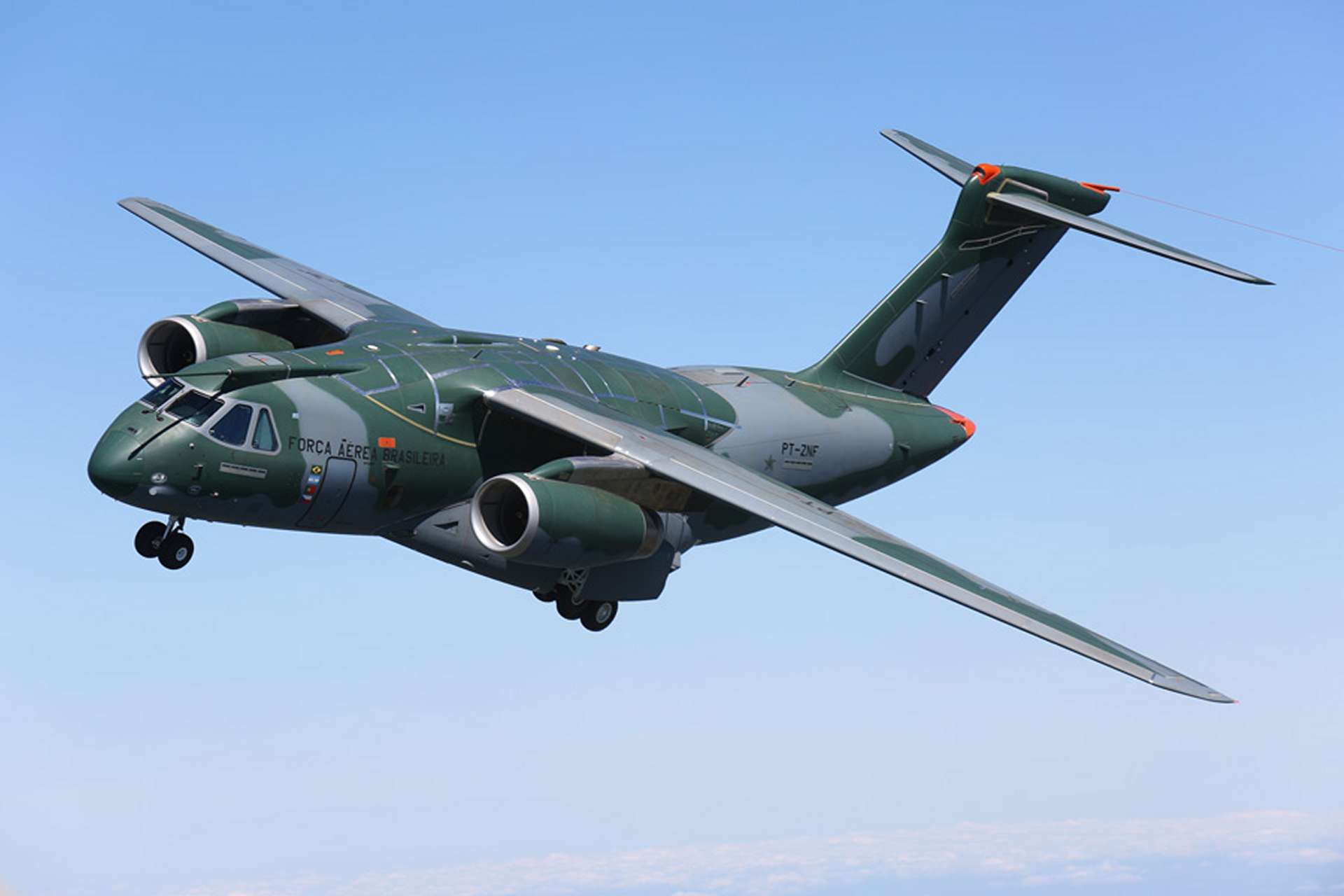
Embraer KC-390 Millennium Military Transport Aircraft (Picture source: Embraer)
From May 20 to 22 2024, a Brazilian delegation of government leaders and businessmen was warmly received by their Egyptian counterparts. A crucial memorandum of understanding was signed between Brasilia and the Arab Organization for Industrialization (AOI), boosting prospects for future collaborations, particularly in the defense sector. Observers see this development as a major turning point, with the Arab-Brazilian Chamber of Commerce (ABCC) playing a facilitating role.
The visit coincides with Embraer's attempts to disrupt an existing agreement between the United States and Egypt for the purchase of twelve C-130s, a deal valued at $2.2 billion that has faced criticism over human rights concerns in Egypt raised by U.S. Senator Rand
military air mobility. The coming months could well mark a decisive turning point in the fierce competition for the medium military transport market.
The Embraer KC-390, also known as the C-390 Millennium, is a versatile aircraft designed by the Brazilian manufacturer Embraer. It was first showcased in 2018 at the Farnborough Airshow. This aircraft is primarily used for military transport and can also serve as a refueling plane. It requires a crew of two and made its first flight on February 3, 2015, officially entering service on September 3, 2019, although it was initially planned to be launched in 2016.
The KC-390 is a robust and spacious aircraft, measuring 33.91 meters in length, with a wingspan of 35.05 meters, and a height of 10.26 meters. Its maximum takeoff weight is 72 tons, and it can carry up to 23.6 tons of cargo. The aircraft is powered by two IAE V2500 turbofan engines, each providing a thrust of 138 kilonewtons, allowing for a maximum cruising speed of 850 km/h (Mach 0.8). It can travel a distance of 2,780 km with a full load and up to 6,200 km when empty. The KC-390 can reach a flight ceiling of 11,000 meters, making it suitable for a wide range of military and humanitarian missions.
https://armyrecognition.com/news/ae...kc-390-millennium-military-transport-aircraft
Users who are viewing this thread
Total: 1 (members: 0, guests: 1)
Pakistan Defence Latest
-
-
Can India’s garments industry benefit from Bangladesh’s turmoil? (3 Viewers)
- Latest: NGAD IS THE BEST
-
-
-
Country Watch Latest
Latest Posts
-
Hundreds of Hezbollah fighters injured after their pagers/phones explode in presumed Israeli operation (43 Viewers)
- Latest: Mehmed Beg
-
-
-
-

